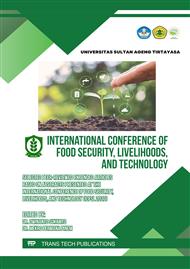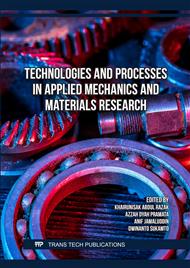[1]
V. Bukarica and Ž. Tomšić, "Energy efficiency policy evaluation by moving from techno-economic towards whole society perspective on energy efficiency market," Renewable and Sustainable Energy Reviews, vol. 70. Elsevier Ltd, p.968–975, 2017.
DOI: 10.1016/j.rser.2016.12.002
Google Scholar
[2]
Z. Morvay and D. Gvozdenac, Applied industrial energy and environmental management. John Wiley & Sons, 2008.
Google Scholar
[3]
D. S. Block, "and Tata Energy Research Institute 1999".
Google Scholar
[4]
S. M. El-Behery, A. A. Hussien, H. Kotb, and M. El-Shafie, "Performance evaluation of industrial glass furnace regenerator," Energy, vol. 119, p.1119–1130, 2017.
DOI: 10.1016/j.energy.2016.11.077
Google Scholar
[5]
M. Hasanuzzaman, N. A. Rahim, M. Hosenuzzaman, R. Saidur, I. M. Mahbubul, and M. M. Rashid, "Energy savings in the combustion based process heating in industrial sector," Renewable and Sustainable Energy Reviews, vol. 16, no. 7. p.4527–4536, Sep. 2012.
DOI: 10.1016/j.rser.2012.05.027
Google Scholar
[6]
E. A. Foumeny and H. Pahlevanzadeh, "Performance evaluation of thermal regenerators," Heat Recovery Systems and CHP, vol. 14, no. 1, p.79–84, 1994.
DOI: 10.1016/0890-4332(94)90074-4
Google Scholar
[7]
Y. Reboussin, J.-F. Fourmigue, P. Marty, and O. Citti, "A numerical approach for the study of glass furnace regenerators," Appl Therm Eng, vol. 25, no. 14–15, p.2299–2320, 2005.
DOI: 10.1016/j.applthermaleng.2004.12.012
Google Scholar
[8]
Y. Reboussin, J. F. Fourmigué, P. Marty, and O. Citti, "A numerical approach for the study of glass furnace regenerators," Appl Therm Eng, vol. 25, no. 14–15, p.2299–2320, Oct. 2005.
DOI: 10.1016/j.applthermaleng.2004.12.012
Google Scholar
[9]
J. Yu, M. Zhang, W. Fan, Y. Zhou, and G. Zhao, "Study on performance of the ball packed-bed regenerator: experiments and simulation," Appl Therm Eng, vol. 22, no. 6, p.641–651, 2002.
DOI: 10.1016/s1359-4311(01)00116-8
Google Scholar
[10]
M. T. Zarrinehkafsh and S. M. Sadrameli, "Simulation of fixed bed regenerative heat exchangers for flue gas heat recovery," Appl Therm Eng, vol. 24, no. 2–3, p.373–382, 2004.
DOI: 10.1016/j.applthermaleng.2003.08.005
Google Scholar
[11]
T. Skiepko and R. K. Shah, "Modeling and effect of leakages on heat transfer performance of fixed matrix regenerators," Int J Heat Mass Transf, vol. 48, no. 8, p.1608–1632, 2005.
DOI: 10.1016/j.ijheatmasstransfer.2004.10.023
Google Scholar
[12]
V. Sardeshpande, U. N. Gaitonde, and R. Banerjee, "Model based energy benchmarking for glass furnace," Energy Convers Manag, vol. 48, no. 10, p.2718–2738, Oct. 2007.
DOI: 10.1016/j.enconman.2007.04.013
Google Scholar
[13]
F. Abbasi and H. Rahimzadeh, "Applying a modified two-fluid model to numerical simulation of two-phase flow in the membrane chlor-alkali cells," 2008.
Google Scholar
[14]
V. Sardeshpande, R. Anthony, U. N. Gaitonde, and R. Banerjee, "Performance analysis for glass furnace regenerator," Appl Energy, vol. 88, no. 12, p.4451–4458, 2011.
DOI: 10.1016/j.apenergy.2011.05.028
Google Scholar
[15]
T. S. Possamai, R. Oba, and V. P. Nicolau, "Investigation and experimental measurement of an industrial melting furnace used to produce sodium silicate," Appl Therm Eng, vol. 85, p.207–213, 2015.
DOI: 10.1016/j.applthermaleng.2015.04.019
Google Scholar
[16]
S. M. Sadrameli, "Mathematical models for the simulation of thermal regenerators: A state-of-the-art review," Renewable and Sustainable Energy Reviews, vol. 58. Elsevier Ltd, p.462–476, May 01, 2016.
DOI: 10.1016/j.rser.2015.12.154
Google Scholar
[17]
S. M. Sadrameli, "Mathematical models for the simulation of thermal regenerators: A state-of-the-art review," Renewable and Sustainable Energy Reviews, vol. 58. Elsevier Ltd, p.462–476, May 01, 2016.
DOI: 10.1016/j.rser.2015.12.154
Google Scholar
[18]
V. Sardeshpande, R. Anthony, U. N. Gaitonde, and R. Banerjee, "Performance analysis for glass furnace regenerator," Appl Energy, vol. 88, no. 12, p.4451–4458, 2011.
DOI: 10.1016/j.apenergy.2011.05.028
Google Scholar
[19]
R. Idem et al., "Practical experience in post-combustion CO2 capture using reactive solvents in large pilot and demonstration plants," International Journal of Greenhouse Gas Control, vol. 40, p.6–25, 2015.
DOI: 10.1016/j.ijggc.2015.06.005
Google Scholar



